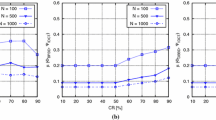Abstract
In order to overcome the shortcomings of existing wireless temperature-humidity monitoring systems, such as high-energy consumption, poor man–machine interaction, differential interference and no reverse real-time control etc., a novel real-time temperature-humidity monitoring system based on short distance wireless microwave communication is designed. In addition, some intelligent algorithms are briefly introduced in wireless communication for frequency assignment, improving energy efficiency and other resource allocation problems. This system uses the chip STC89C52 as the control chip, chip SHT11 as the data acquisition module, chip nRF905 as wireless transceiver module and chip MAX232 as the serial interface between the upper and the lower computer. The system requirements, system design, correlative hardware circuits, control flow chart and software design are depicted in details. This system can realize data acquisition, processing, transmission, control and display of temperature and humidity information. The system functions verification and performance test results show that this system has strong interference, low energy consumption and high precision. This system has great valuable, which has been applied in industrial and agricultural fields, such as greenhouse cultivation and laboratory storage.












Similar content being viewed by others
References
Baker N (2005) ZigBee and Bluetooth: strengths and weaknesses for industrial applications, Computing and Control Engineering 16:20–25. doi: 10.1049/cce: 20050204
Bhattacharjee S, Bandyopadhyay S (2014) Interference aware energy efficient multipath routing in multihop- wireless networks, J High Speed Networks 20(4):263–276. doi:10.3233/JHS-140503
Cai Y, Wang J, Chen Y, Wang T, Tian H, Luo W (2014) Adaptive direction information in differential evolution for numerical optimization, In press, Soft Computing. doi:10.1007/s00500-014-1517-0
Castiglione A, De Santis A, Palmieri F et al (2013) An energy-aware framework for reliable and secure end-to-end ubiqutious data communications[C], Intelligent Networ king and Collaborative Sytems (INCos), 5th International Conference on. IEEE 157–165:2013. doi:10.1109/INCo
Castiglione A, Palmieri F, Fiore U et al (2014) Mode- ling energy-efficient secure communi- cations in multi-mode wireless mobile devices. J Comp Syst Sci. doi:10.1016/jcss.2014.12.022 (ISSN: 0022-0000)
Izadi D, Abawajy J, Ghanavati S (2013) Fuzzy logic optimized wireless sensor network routing protocol, J High Speed Networks 19(2):115–128. doi:10.3233/JHS-130467 (ISSN: 0926-6801)
LIU J (2011) Advanced PID control and MATLAB simulation. Publishing House of Electronics Industry (ISBN: 9787121130496)
Jia Q, Wang D, Zhang Z (2008) Design of wireless data transmission system based on nRF905, International Electronic Elements, 29–31 (ISSN: 1006-6997)
MIL-STD-810F (2000) Environmental Engineering Considerations and Laboratory Test
Nordic VLSI ASA (2005) Single Chip 433/868/915 MHz Transceiver NRF905 datasheet, Norway Nordic
Razavi B (2011) RF Microelectronics International Edition (ISBN: 9780137134731)
Richard CD, Bishop Robert H (2012) Modern control system. Science Publishing House, Beijing (9780131 383104)
SHTlx/SHT7x Humidity & Temperature Sensor Datasheet, Sensirion, 2005
Wang J, Cai Y (2015) Multiobjective evolutionary algorithm for frequency assignment problem in satellite communications, Soft Computing, 19(5):1229–1253. doi:10.1007/s 00 500-014-1337-2 (ISSN: 14327643)
Xue M (2010) Low-power Temperature and Humidity Mea- surement System Based on nRF905, XianDai- DianZi jishu, 135–138 (ISBN: 978711518 5105)
Yang S, Jin H (2012) Distributed temperature and humidity acquisition system based on IA4421//Electrical & Electronics Eng- ineering (EEESYM), 2012 IEEE Symposium on IEEE, 289–292. doi:10.1109/EEESym.2012.6258646
Zeng L, Zhang H, Hou W (2011) Design and Implement of WiFi Wireless Measur ement and Control Network, Electri cal Measurement and Instrumentation, 7:1001–1390. doi:10.3969
Acknowledgments
This work was financially supported by National Natural Science Foundation of China (Grant No. 51305142, 61305085), Natural Science Foundation of Fujian Province of China (No. 15141112, 11145006, 11145007), the General Finan- cial Grant from the China Postdoctoral Science Foundation(Grant No:2014M552429), project of Xia men science and technology plan(3502Z20143041), introduction of talents Huaqiao University Scientific Research Projects (Project No.12BS217) and the Promotion Program for Young and Middle-aged Teachers in Science and Technology Research at Huaqiao University under Grant ZQN-PY212.
Author information
Authors and Affiliations
Corresponding author
Rights and permissions
About this article
Cite this article
Guan, W., Wang, C., Cai, Y. et al. Design and implementation of wireless monitoring network for temperature-humidity measurement. J Ambient Intell Human Comput 7, 131–138 (2016). https://doi.org/10.1007/s12652-015-0314-7
Received:
Accepted:
Published:
Issue Date:
DOI: https://doi.org/10.1007/s12652-015-0314-7




